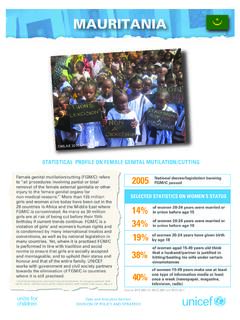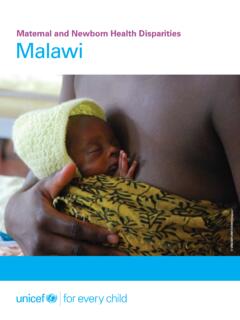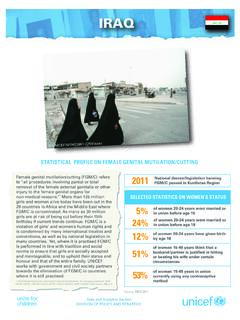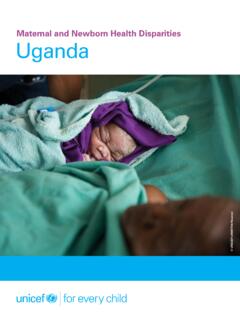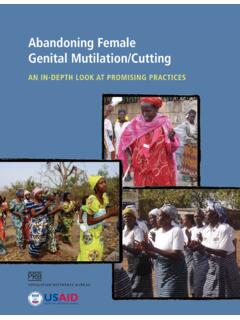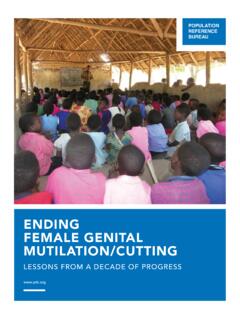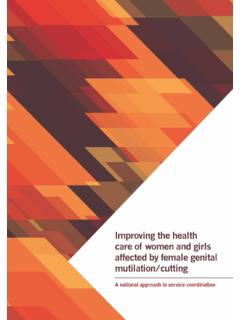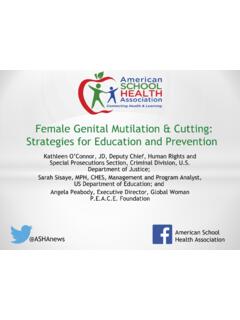Transcription of GAMBIA - UNICEF STATISTICS
1 STATISTICAL PROFILE ON female GENITAL mutilation / cutting 1 World Health Organization, Eliminating female Genital mutilation : An interagency statement, WHO, UNFPA, UNICEF , UNIFEM, OHCHR, UNHCR, UNECA, UNESCO, UNDP, UNAIDS, WHO, Geneva, 2008, p. 4. SELECTED STATISTICS ON WOMEN S STATUS Guinea GAMBIA Source: DHS 201330%9%of women 20-24 years were married or in union before age 15of women 20-24 years were married or in union before age 1819%of women 20-24 years have given birthby age 1858%of women 15-49 years think that a husband/partner is justified in hitting orbeating his wife/partner under certain circumstances70%of women 15-49 years make use of at least one type of information media at least once a week (newspaper, magazine, television or radio) National decree/legislation banningFGM/C passed UNICEF /NYHQ2009-0838/ParkerFemale genital mutilation / cutting (FGM/C) refers to all procedures involving partial or total removal of the female external genitaliaor other injury to the female genital organs for non-medical reasons.
2 1 FGM/C is a violationof girls and women s human rights and is condemned by many international treaties and conventions, as well as by national legislation in many countries. Yet, where it is practised, FGM/C is performed in line with tradition and social norms to ensure that girls are socially accepted and marriageable, and to uphold their status and honour and that of the entire family. UNICEF works with government, civil society partners and other UN agencies towards the elimination of FGM/C in countries where it is still practised. Data and Analytics SectionDIVISION OF DATA, RESEARCH AND POLICY201586 12 1 757972 77 210 20 40 60 80 100 Total RuralUrbanMuslim Christian 99 1 Three in four girls and women of reproductive age have undergone FGM/CMore than half of girls and women were subjected to FGM/C before age fiveHOW WIDESPREAD IS THE PRACTICE?
3 WHEN AND HOW IS FGM/C PERFORMED? P15-49 years who have at least one daughter who has had FGM/C, by place of residence and mother's educationPercentage distribution of most recently cut daughters, by daughter's age at cutting Percentage of girls and women aged 15-49 yearswho have had FGM/C, by pr fecturePercentage of girls and women aged 15 to 49 yearswho have undergone FGM/C,by local government areasPercentage of girls and women aged 15 to 49 years who have undergone FGM/C,by place of residence and religionPercentage of girls aged 0 to 14 years who have undergone FGM/C (as reportedby their mothers), by residence, mother's education and wealth quintileAmong daughters of cut girls and women, the percentage of girls aged0 to 14 years who have undergone FGM/C, by mothers' attitudesabout whether the practice should continuePercentage distribution of girls and women aged 15 to 49 years who have undergone FGM/C, by age at which cutting occurred0 20 40 60 80 100 Source for all charts on this page: DHS 2013, unlessotherwise : The boundaries and the names shown and the designations used on the map do not imply official endorsement or acceptance by the United Nations.
4 Only categories with 25 or more unweighted cases are presented. Due to rounding, some of the data presented may not add up to 100 per cent. Prevalence data for girls aged 0 to 14 reflect their current, but not final, FGM/C status since some girls who have not been cut may still be at risk of experiencing the practice once they reach the customary age for cutting . Therefore, the data on prevalence for girls under age 15 is actually an underestimation of the true extent of the practice. Since age at cutting varies among settings, the amount of underestimation also varies and this should be kept in mind when interpreting all FGM/C prevalence data for this age group. Data on the prevalence of FGM/C among daughters of mothers who are unsure about the continuation of the practice are based on 25-49 unweighted cases.
5 Data for girls and women are used to report on age at cutting since the earlier MICS (2005-2006) did not have questions on age at cutting for most recently cut daughters. Health personnel includes doctors, nurses, midwives and other health workers; Traditional practitioner includes traditional circumcisers, traditional birth attendants, traditional midwives and other types of traditional practitioners. The 2013 DHS did not collect data on the prevalenceof FGM/C among girls aged 0 to 14 years. Percentage distribution of girls aged 0 to 14 years who have undergone FGM/C (as reported by their mothers), according to the type of person/practitioner performing the procedure020406080100 HOW WIDESPREAD IS THE PRACTICE?WHEN AND HOW IS FGM/C PERFORMED? 0-4 years5-9 years10-14 years15+ yearsDon t know/MissingPercentage distribution of girls aged 0 to 14 years who have undergone FGM/C (as reported by their mothers), by the type of FGM/C performedTraditionalpractitionerHealth personnelDon t know/Missing Cut, flesh removedType not determined/Not sure/Don t knowSewn closed56 60 51 59 51 42 51 45 0 20 40 60 80 100 Total Rural Urban No education Primary complete Secondary or higher Poorest Richest 7554 Daughters whosemothers areunsureDaughters whosemothers thinkFGM/C should stop 0 20406080100606626% - 50%51% - 80%Above 80%10% - 25%Less than 10%Source: MICS 2010 Source: MICS 2010 Source: MICS 2010 Source.
6 MICS 2010 Daughters whosemothers thinkFGM/C shouldcontinueDaughters whosemothers say itdepends 5591728 Percentage of girls and women aged 15 to 49 years who have undergone FGM/C, by current agePercentage of girls and women aged 15 to 49 years who have heard about FGM/C, by their attitudes about whether the practice should continueAlmost two of three girls and women in GAMBIA support the continuation of FGM/CSource for all of the above charts: DHS 2013, unless otherwise girls and women aged 15 to 49 years who have heard about FGM/C, the percentage who cite specific benefits or advantages for a girl to undergo the procedureFor self-esteemOtherNo benefitsPreservation of virginityPrevent fooling aroundDon t know37 28 19 1714 6 Percentage of girls and women aged 15 to 49 years who have heard about FGM/C and think the practice should continue,by wealth quintile, education, religion and agePercentage of girls and women aged 15 to 49 years who have undergone FGM/C, and percentage of girls and women aged 15 to 49 years whohave heard about FGM/C and think the practice should continue.
7 By survey year78767164 0 20 40 60 80 100 Prevalence of FGM/C Think FGM/C should continue There has been no significant change in the prevalence of FGM/C in GambiaWHAT ARE THE PREVAILING ATTITUDES TOWARDS FGM/C?IS THE PRACTICE OF FGM/C CHANGING?7675 777474747645-49 40-44 35-39 30-34 25-29 20-24 15-19 65705367 7360 671667670 20 40 60 80 100 Total Poorest Richest No education Primary complete Secondary or higher MuslimChristian45-49 years 15-19 years 0 20 40 60 80 100 Think FGM/C should continue Think FGM/C should stop Say it depends/are not sure 0 100 20 40 60 80 23365 Source: MICS 2010 MICS 2005-2006 MICS 2010 DHS 20137565 INTER-COUNTRY STATISTICAL OVERVIEWGAMBIA Sources: DHS, MICS, Population and Health Survey, RISKESDAS and Welfare Monitoring Survey, 2004-2015.
8 Data and Analytics Section - Division of Data, Research and PolicyUNICEF, 3 UN Plaza, New York, 1 0017 Website: Email: MORE INFORMATIONThe Data and Analytics Section gratefully acknowledges inputs shared by UNICEF country February 2016 Notes: Egypt data refer to girls aged 1-14 years and Indonesia data refer to girls aged 0-11 years. An older source is used to report on the prevalence of FGM/C among girls aged 0-14 years for GAMBIA (MICS 2010) since the 2013 DHS did not collect these data. MICS data for Ghana (2011) could not be used to report on attitudes towards FGM/C due to the fact that information is missing for girls and women with no living daughters; data from MICS 2006 are used instead. In Liberia, only cut girls and women were asked about their attitudes towards FGM/C; since girls and women from practising communities are more likely to support the practice, the level of support in this country as captured by the 2013 DHS is higher than would be expected had all girls and women been asked their opinion.
9 Prevalence data on FGM/C for girls and women aged 15-49 years and data on attitudes towards FGM/C are not available for Indonesia. 1 2 35 6 6 6 7 9 9 11 12 131416 192331 373839414154 6565 6973 76 Benin Togo Ghana Niger Iraq Cameroon Uganda Burkina Faso Kenya C te d'Ivoire Senegal Nigeria Ethiopia Guinea-Bissau Djibouti Chad Mauritania Yemen Sudan Liberia Eritrea Egypt GAMBIA Somalia Sierra Leone Guinea Mali 1 1 2 4 5 8 9 15 1921 24252538 44 4550 69 74 7576 83 878789 9093 97 98 0 20 40 60 80 100 Cameroon Uganda Niger Ghana Togo Iraq Benin Yemen Central African Republic C te d'Ivoire Chad Guinea-Bissau Liberia Mauritania Ethiopia Egypt Djibouti Guinea Somalia United Republic of Tanzania 0 20 40 60 80 100 Central African Republic United Republic of Tanzania Percentage of girls and women aged 15 to 49 years who have heard about FGM/C and think the practice should
10 ContinuePercentage of girls and women aged 15 to 49 years who have undergone FGM/CPercentage of girls aged 0 to 14 years who have undergone FGM/C (as reported by their mothers)0 20 40 60 80 100 113214172433495456 TogoGhanaCentral AfricanRepublicUgandaEritreaSenegalBurki na FasoGuineaEgyptSudanMauritaniaGambiaC te d'Ivoire13 Indonesia30 Benin Senegal Nigeria GAMBIA Burkina Faso Sierra Leone Mali Eritrea Sudan Egypt
